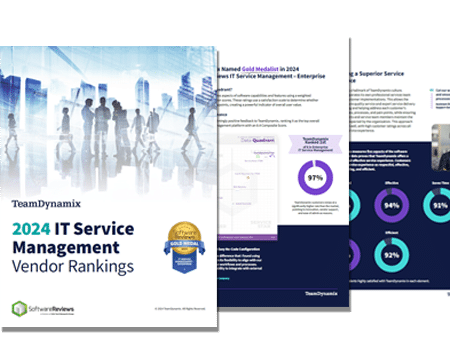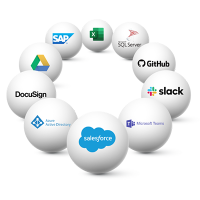
Understanding Change Management and Its Importance Within Your Organization
Did you know that a significant number of IT incidents occur when someone makes a change to one system that then affects other systems in

The Info-Tech ranking report offers a unique view of the market based entirely on in-depth customer interviews. Download the Info-Tech ITSM Quadrant and Customer Viewpoint report today.

We’ll show you some of our best situations and show you exactly how to execute them to get immediate results. The best part is, iPaaS tools often feature easy-to-use click and drag functionality, meaning you don’t need a dedicated employee building integrations and workflows.

System Integrators, Value Added Resellers, Technology Providers, and Buying Consortiums can benefit from a partnership with TeamDynamix.

The Info-Tech ranking report offers a unique view of the market based entirely on in-depth customer interviews. Download the Info-Tech ITSM Quadrant and Customer Viewpoint report to gain a better understanding of key vendor strengths and emerging market requirements.
With so many options available when it comes to IT Service Management (ITSM) software, it can be hard to figure out which vendor makes the most sense for your business or organization.
Do you go with a big vendor that can be complex, needs a team to run it and can cost a lot year over year?
Or do you go with a more simplistic tool that does just the basics, but lacks some of the other functionality you might need as you grow or scale your ITSM services?
Is there an ITSM tool that falls somewhere in the middle with everything you need at the right price?
There’s a lot of conflicting advice out there, and certainly no shortage of reviews to sort through.
Here are three common misconceptions you should consider when shopping for new ITSM software so you can set yourself, and your business or organization, up for success.
Many times, organizations will take on an ITSM tool that’s too large and too complex for their organization’s needs. They are sold on a brand name and features and functionalities that, in fact, they don’t necessarily need or will practically use once the ITSM tool is in place. This often results in them paying for licensing fees or modules they don’t need. In fact, sometimes organizations will report they have as many as 8 dedicated resources administering their ITSM tool; often consuming technical experts to create forms, workflows, integrations and scripts.
This was the case at the University of Michigan, and why it recently made the switch to TeamDynamix for ITSM. Unhappy with its former ITSM tool, the university’s ITS team selected TeamDynamix because it believes the ITSM platform can help them identify problems and repeated requests, automate workflows, and help users find their own answers to questions whenever possible. They also wanted to invest in a future vision that would allow them to embrace true enterprise service with this new software.
In addition, the enterprise site licensing model for TeamDynamix allows the university to have more people resolving service tickets, resulting in improved problem resolution and an improved experience for students, faculty, and staff. This was put into practice amid the shift to remote learning when the pandemic emerged, helping ITS respond to a sharp spike in service requests.
Without the right ITSM tool in place, it can be hard to find success with digital transformation initiatives and organizational change.
At Charter Oak Financial, people, processes and platforms make up the three factors for success, “It’s a three-legged stool,” Deborah Rojas, Chief Information Officer, said. “You can’t really have any of those legs longer or shorter than the others. Balance is important.”
When Charter Oak replaced its aging ticketing system with TeamDynamix, Rojas and her team knew they were addressing the “platforms” and “processes” legs of the stool. They didn’t fully realize how much of an impact the software would have on the “people” component as well.
Sharing the view from her seat, Rojas said, “The financial services sector ultimately wants to be on the bleeding edge of technology. If you don’t have a good way of handling project management, hearing the voice of your customers, quickly resolving customer issues, and staying inside the regulatory box, I think you’re at a big disadvantage.”
TeamDynamix became the solution, offering automated workflows and seamless integrations with enterprise software. “TeamDynamix is allowing us to innovate more than we’ve been able to in the past,” she said.
No matter the vendor you select, the ITSM software you pick for your organization should be easy to use, easy to own and easy to operate.
Codeless ITSM platforms, like TeamDynamix, are a great place to start. Not only do they have the flexibility you need, but they also often have a lower total cost of ownership as you don’t need a full team to manage the software. In fact, with a codeless system, you can empower employees across the organization to manage their own portals and tickets.
A user-friendly, searchable knowledge base can be the single most valuable tool your organization has. Not only can you use a knowledge base internally to help employees answer any questions they may have about your business or organization, or how to do things within their departments – but you can create a knowledge base as part of an external self-service portal that you can direct customers to in order to deflect calls and emails that would otherwise come to your help desk.
By utilizing a self-service portal with a knowledge base, you can save both time and money. Here are some other benefits of having a knowledge base:
By using a methodology like Knowledge-Centered Service® (KCS) to build your knowledge base you can quickly cut down on the amount of time your IT team spends on resolving tickets.
At the University of South Dakota (USD) they built out their knowledge base using KCS and quickly saw an 18% reduction in time logged to service tickets. After just six months, their portal had grown exponentially with more than 31,000 users, 262,000 page views and 5,000 knowledge articles being included in the knowledge base.
At the City of Madison – self-service is a top priority.
The IT team implemented TeamDynamix ITSM with PPM – focusing on self-service to kick off the city’s IT service delivery transformation according to Abigail Ferguson, Customer Success Manager for the City of Madison’s Information Technology.
“Our client portal will really open up the gateway to all city staff to be able to request IT services and also access the self-service portion of our portal,” Ferguson said. “It’s really going to be a game changer for us because it will be consolidating all of the different places people used to go for resources.” With this key pillar in place, the team can further build out the knowledge base to expedite self-service resolution.
The IT customer portal has been a big project for the City of Madison IT team. Not only will it consolidate all of the different resource areas currently in use, but it will house two knowledge bases. The first is an internal IT knowledge base that will serve as a place for IT staff to quickly locate information and answers as needed to address tickets and requests.
The second knowledge base will be geared towards self-service for staff and citizens who want to locate answers themselves. “This will allow us to attach articles to tickets and teach people along the way how to find the answers they need. This will really empower our customers with resources and knowledge,” Ferguson said.
And ultimately, this improved self-service experience will help the city IT team lower ticket volumes.
“We are seeing the same resource constraints other cities are,” she said. “We are understaffed at times and need to focus on higher-value implementations. So, anything we can do to empower our users to find the resources they need for self-service is a must for us.”
Often, departments work in silos and have their own tech stacks. And while this can work for many specific types of software, there are instances where this can become a hindrance for business or organization – especially when resource optimization and project planning happen across departments.
In these cases, investing in an ITSM tool that includes Project Portfolio Management (PPM) along with enterprise integration and automation makes sense. Whether you need all three, or a mix of two – a vendor that can give you the option to scale your needs as you grow into Enterprise Service Management (ESM) is key.
By bringing ITSM and PPM together on a single platform, you can better understand your resource capabilities and engage in true resource capacity planning.
With resource capacity planning you get a big-picture view of your entire IT organization, allowing you to balance workloads across projects and support; and to see the different types of work that need to be done at any given time.
For example, if you have three IT technicians that need to cover three functional areas of business – like service, projects and operations – you can engage in resource capacity planning and optimize each technician’s workload based on their skill set and their availability. As a result, the work can be completed more effectively and efficiently as each technician is focused on work that plays to their strengths. And because you have a full view of the work and the time it will take, you can avoid overcommitting or underutilizing your resources.
This approach is especially useful when you have limited resources, but an increase in demand for the support of remote learning and remote workforces.
When you add in iPaaS (integration platform as a service) with your ITSM/PPM platform you can automate both complex and simple tasks, as well as connect disparate systems throughout your organization.
Employees no longer need to spend time on the repetitive, mundane tasks they normally have to complete before working on bigger projects – things like system name changes, resetting passwords, or granting certain permissions to software. All of these, and more, can be automated with workflows using iPaaS.
If you choose a codeless platform for this, you get the added benefit of anyone being able to use these tools – not just IT. By allowing lines of business to create their own workflows you can free up your IT resources to work on larger projects and eliminate the logjam when it comes to integrations within your organization.
Here are a few other ways iPaaS can supercharge service delivery and reduce the IT drain on an organization:
Festival Foods, a grocery store chain in the Midwest, liked the appeal of having ITSM, PPM and iPaaS together on one platform.
The platform’s “low-code, no-code” design makes configuration and operation a breeze. Creating custom forms, fields, workflows and portals is easy and does not require any coding and scripting – making the platform very easy to administer and easy to deploy to other groups such as HR and Facilities.
“This tool can run itself,” Alex Turek, IT service desk manager for Festival Foods, said. “I’m impressed with the lack of coding knowledge and IT terminology you need to know to set it up. It’s drag and drop, and it’s completely customizable. There’s not a lot of work we have to do to maintain it. It just works.”
“Before, we had no project governance process,” he explained. “It was very ad-hoc. Whoever could scream the loudest got the most IT resources. Finding a tool that also included PPM was huge.”
Managing projects and IT services within the same platform has brought significant benefits, leading to improved efficiency and accountability.
“Technicians can see their project work and their IT work in one space,” Turek said. “This means it’s easier to communicate and ensure follow-through. Project managers can assign tasks to my service desk team within the same dashboard they’re using to resolve tickets. Those pop right up, helping them be aware of all their tasks and priorities so they can easily meet their deadlines.”
The next step for Turek and his team is to leverage the integration Platform-as-a-Service (iPaaS) capabilities within TeamDynamix to automate their most repetitive processes.
“We’re looking to automate tasks such as password resets, user account deactivation, user onboarding and other tasks we do often, so we can reduce the daily workload on our team,” Turek said.
Want to learn more about selecting the right ITSM software for your business? Download the ITSM selection guide from Info-Tech.

Did you know that a significant number of IT incidents occur when someone makes a change to one system that then affects other systems in

The construction industry can be very volatile, with a high employee turnover rate due to seasonal fluctuations in the workforce. A key challenge for the

A study from Information Week and TeamDynamix shows companies are looking to invest in IT Service Management (ITSM) software that is simple to administer and
TeamDynamix’s award-winning SaaS cloud solution offers IT Service and Project Management together on one platform with enterprise integration and automation.
[email protected]
(877) 752-6196
Contact Us
